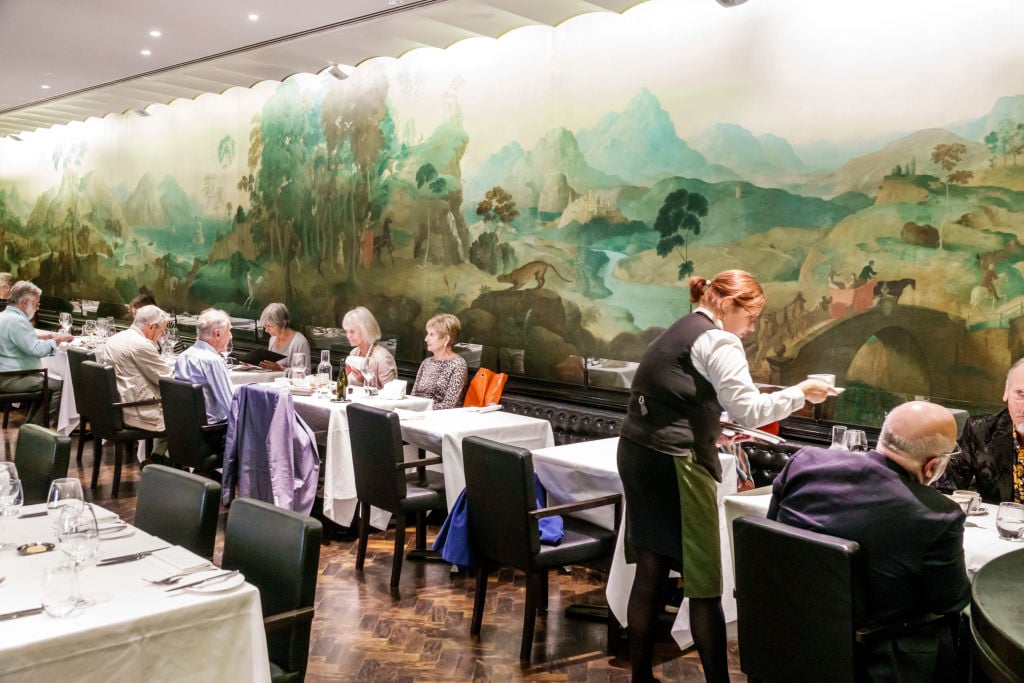
Guests dining at the Tate Britain’s luxurious Rex Whistler restaurant have been clinking china and enjoying amuse-bouches for years alongside a massive mural that depicts child slavery. But now, amid mounting backlash over the painting, Rex Whistler’s The Expedition in Pursuit of Rare Meat (1927), the museum has updated its website to amend references to the restaurant.
The mural includes two instances of white people towing black children with what appears to be a rope within a larger scene that depicts a hunting expedition outside of a villa. Another scene shows Chinese figures in what the museum acknowledges “suggests caricature.”
Following outcry on social media, Tate Britain recently removed a reference on its website calling the venue the “most amusing restaurant in the world,” as well as a quote from a Guardian article that called its wine list “a greedy little secret.”
The Instagram of the editorial platform The White Pube, which first reported the changes to the museum’s website, previously called attention to the mural’s racist imagery. “How do these rich white people still choose to go there to drink from ‘the capital’s finest wine cellars’ with some choice slavery in the background? @Tate you are all deranged,” they stated. Its authors, Gabrielle de la Puente and Zarina Muhammad, did not respond for a request for comment.
The next day, the White Pube posted online that the Tate quietly changed the description of the work on their website. Artnet News confirmed that Tate updated the webpage at the end of last week, and that they had added the interpretation text that has been on-site at the restaurant since last year.
“Tate has been open and transparent about the deeply problematic racist imagery in the Rex Whistler mural,” said a Tate spokesperson in a statement. “In the context of the mayor of London’s recently announced public realm review, we welcome further discussion about it. Having been commissioned for the restaurant walls in 1927, the mural was one of the artist’s most significant works and is part of a Grade I-listed historic interior. But it is important to acknowledge the presence of offensive and unacceptable content and its relationship to racist and imperialist attitudes in the 1920s and today.”
Onetime museum director Charles Aitken commissioned the work when Whistler was only 22 and a young Slade School of Art graduate. It was restored in 2013 as part of a £45 million ($59 million) renovation at the London museum. Last year, the museum added an accompanying text acknowledging the racist imagery.
This interpretation text, which has been online since last week, notes that while the painting is one of Whistler’s “most important works,” it contains a number of scenes that are “unacceptable.” The imperialist mural depicts the Duke of Epicurania venturing out to various countries and natural landscapes before he and his court return back to their palatial villa.
“Whistler’s treatment of non-white figures reduces them to stereotypes,” reads the interpretative text that has now been added to the website. “These depictions demonstrate attitudes to racial identity prevalent in Britain in the 1920s. The weakening of the British Empire around this time paradoxically prompted cultural expressions of the superiority of the ‘British race.’”
A petition demanding the mural’s removal had gained 458 signatures by publication time. “Tate Britain allowing this overtly racist painting to remain for diners enjoyment is not acceptable,” states the petition. “Changes need to be made in either removing the painting from the restaurant or removing the restaurant from mural room itself—there simply should not be a dining experience open in this modern and multicultural Britain, where all races are not respected.”
“The interpretation text on the wall alongside the mural and on the website addresses this directly as part of our ongoing work to confront such histories, a process that goes hand in hand with championing a more inclusive story of British art and identity today,” said the museum spokesperson.